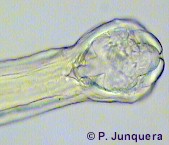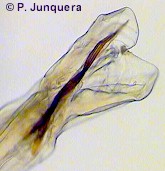Bunostomum is a genus or parasitic roundworms that belongs to the group of hookworms that affects cattle, sheep, goats and other wild and domestic ruminants (deer, antelopes, camelids, etc.).
that belongs to the group of hookworms that affects cattle, sheep, goats and other wild and domestic ruminants (deer, antelopes, camelids, etc.).
It is found worldwide, but is more abundant in regions with a warm and humid weather. Studies in Europe showed up to 5% prevalence in sheep (Germany) and 30% in cattle (Switzerland).
The most relevant species for livestock are:
- Bunostomum phlebotomum. Infects cattle and other bovids, very seldom sheep and goats.
- Bunostomum trigonocephalum. Infects sheep and goats, very seldom cattle.
Pigs, dogs and cats are not affected by these worms.
The disease caused by Bunostomum worms is called bunostomosis.
Is livestock infected with Bunostomum worms contagious for humans?
- NO but: Direct contact with livestock or their fresh feces is not contagious for humans because the eggs shed with the feces have to mature in the environment to become infective. But larvae in the environment may infect humans through the skin, e.g. after walking barefoot on contaminated pasture. However, human infections are rather benign and may cause only an inflammation of the skin due to the migrating larvae (cutaneous larva migrans) the resolve spontaneously. Such larvae won't continue to the intestine and will not complete development to adult worms. Such human infections with Bunostomum worms are anyway very seldom. For more details about the life cycle of these worms see below.
You can find additional information in this site on the general biology of parasitic worms and/or roundworms.
Final location of Bunostomum worms
Predilection site of adult Bunostomum worms is the small intestine. Larvae may be found transiently in the skin, the blood, the lungs and the trachea.
Anatomy of Bunostomum worms

Adult Bunostomum worms have a grayish to whitish color and are 1 to 3 cm long and quite thick, whereby females are larger than males. As in other roundworms, the body of Bunostomum worms is covered with a cuticle, which is flexible but rather tough. The worms have no external signs of segmentation.
They have a tubular digestive system with two openings. They have a characteristic funnel-shaped mouth capsule armed with to cutting plates to attach to the gut's lining. They also have a nervous system but no excretory organs and no circulatory system, i.e. neither a heart nor blood vessels.
Males have two spicules for attaching to the female during copulation. The spicules of Bunostomum phlebotomum are very thin and long, those of Bunostomum trigonocephalum are shorter and alated.
The eggs are ovoid but with an irregular shape, measure ~55x95 micrometers, and contain 4 to 8 cells when shed.
Life cycle of Bunostomum worms
All Bunostomum species have a direct life cycle, i.e. there are no intermediate hosts involved. Adult females lay eggs in the intestine of the host that are shed with the feces.
Once in the environment the eggs release the L1-larvae that complete development to infective L3-larvae in about 5 days by suitable weather (hot and humid), significantly longer by cold weather. By warm weather these infective larvae may survive for up to 2 months on pasture. They do not survive the winter in regions with a temperate climate (e.g. Europe, Canada, etc).
Livestock becomes infected either through the skin (the most frequent way), or after ingesting infective larvae with pasture, contaminated soil or water. Larvae that penetrate into the skin reach the bloodstream and are carried to the lungs, where they cross the lung tissue, get to the trachea and the mouth (coughing, expectorations, etc.) and reach the intestine after being swallowed. There they complete development to adult worms and females start laying eggs.
The prepatent period (time between infection and first eggs shed) is 7 to 9 weeks, depending of the species and the host.
Harm caused by Bunostomum worms symptoms and diagnosis
The strong mouth capsule of adult worms causes heavy lesions in the intestinal wall, often with rupture of intestinal blood vessels, with the subsequent blood loss. Larvae that penetrate the skin (mainly through the feet and limbs) can be highly irritating for livestock. Bunostomum worms belong to the most harmful in warm and moist regions. Unweaned calves and lambs are particularly at risk during the rainy season: already 50 to 200 worms can cause anemia. Over 2000 worms can be fatal for calves, and over 300 worms for lambs.
Typical symptoms are diarrhea (often mucous or hemorrhagic), dehydration, loss of appetite, weakness, weight loss or reduced growth, bottle jaw (submandibular edema). Larvae that penetrate the skin can cause dermatitis (including itching, swelling, redness, thickening), hair loss, rough coat and damaged hooves. Affected lungs can cause coughing.
Since most infections are mixed with other gastrointestinal roundworms (e.g. Cooperia spp, Haemonchus spp, Ostertagia spp, Trichostrongylus spp, etc.) it is often difficult to ascribe the damage to Bunostomum or to other worms.
Diagnosis is based on the clinical signs and confirmed after detection of characteristic eggs in the feces. However, it is difficult to distinguish the eggs of Bunostomum from other gastrointestinal roundworms. L3 larvae obtained after in-vitro culture of eggs may be required for specific diagnosis.
Prevention and control of Bunostomum infections
In contrast with other gastrointestinal roundworms, tall pasture favors transmission of Bunostomum worms. This is due to the fact that tall grass retains more moisture, which allows infective larvae to swim to the tip of the grass blade, from where it is easier to reach the skin of their hosts. Therefore it is very important to keep livestock away from moist pastures.
Indoor transmission is possible and therefore facilities have to be kept as dry and clean as possible, because humid bedding and dirt favors the development and survival of infective larvae.
Bunostomum worms are quite species-specific and larvae do not survive longer than about 2 months on pasture. Consequently, alternate grazing (e.g. cattle followed by sheep or horses with 2-3 months interval) can help reduce pasture contamination with Bunostomum worms. However, this may be unadvisable for the prevention of other gastrointestinal worm species that infect both cattle and sheep.
As a general rule, whatever reduces pasture contamination with infective larvae (e.g. adequate pasture rotation) or exposure of livestock to such larvae will diminish the impact on the herd. Such preventative measures are the same for all gastrointestinal roundworms and are explained in a specific article in this site (click here).
Livestock exposed to these worms often develop natural resistance progressively and may recover spontaneously. Such resistant animals do not become sick if re-infected, but continue shedding eggs that contaminate their environment.
Numerous broad spectrum anthelmintics are effective against adult worms and larvae, e.g. several benzimidazoles (albendazole, febantel, fenbendazole, mebendazole, oxfendazole, etc.), levamisole, as well as several macrocyclic lactones (e.g. abamectin, doramectin, eprinomectin, ivermectin, moxidectin).
A few other narrow-spectrum anthelmintics such as closantel, nitroxinil are effective against adult worms but may not control larvae and other roundworm species that often infect livestock simultaneously with Bunostomum worms.
Depending on the country most of these anthelmintics are available for oral administration as drenches, feed additives and/or tablets. Levamisole and most macrocyclic lactones are usually also available as injectables. A few active ingredients are also available for livestock as pour-ons and slow-release boluses.
Numerous commercial products contain mixtures of two or even more active ingredients of different chemical classes. This is done to increase the chance that at least one active ingredient is effective against gastrointestinal worms that have become resistant, or to delay resistance development by those worms that are still susceptible.
Excepting slow-release boluses, most wormers containing benzimidazoles (e.g. albendazole, febantel, fenbendazole, flubendazole, mebendazole, oxfendazole, etc.), levamisole, tetrahydropyrimidines (e.g. morantel, pyrantel) and other classic anthelmintics kill the worms shortly after treatment and are quickly metabolized and/or excreted within a few hours or days. This means that they have a short residual effect, or no residual effect at all. As a consequence treated animals are cured from worms but do not remain protected against new infections. To ensure that they remain worm-free the animals have to be dewormed periodically, depending on the local epidemiological, ecological and climatic conditions. An exception to this are macrocyclic lactones (e.g. abamectin, doramectin, eprinomectin, ivermectin, moxidectin), that offer several weeks protection against re-infestation, depending on the delivery form and the specific parasite.
There are so far no true vaccines against Bunostomum worms. To learn more about vaccines against parasites of livestock and pets click here.
Biological control of Bunostomum worms (i.e. using its natural enemies) is so far not feasible. Learn more about biological control of worms.
You may be interested in an article in this site on medicinal plants against external and internal parasites.
Resistance of Bunostomum worms to anthelmintics
There are only few reports on resistance of Bunostomum worms to most used anthelmintics (benzimidazoles, ivermectin, levamisole, etc) in sheep, goats and cattle. It seems that it is not such a serious problem as with other gastrointestinal roundworms (e.g. Cooperia spp, Haemonchus spp, Ostertagia spp, Trichostrongylus spp, etc.).
This means that if an anthelmintic fails to achieve the expected efficacy against Bunostomum worms, there is a certain risk that it is due to resistance to anthelmintics, particularly in sheep, goats and cattle. However, it is well known that many cases of product failure are due to incorrect use of a product, or to the use of an unsuited product, not to resistance.
Learn more about parasite resistance and how it develops.
|
Ask your veterinary doctor! If available, follow more specific national or regional recommendations for Bunostomum control. |